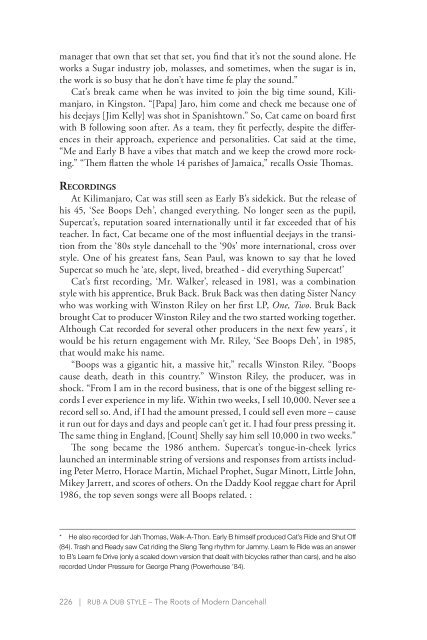Create successful ePaper yourself
Turn your PDF publications into a flip-book with our unique Google optimized e-Paper software.
manager that own that set that set, you find that it’s not the sound alone. He<br />
works a Sugar industry job, molasses, and sometimes, when the sugar is in,<br />
the work is so busy that he don’t have time fe play the sound.”<br />
Cat’s break came when he was invited to join the big time sound, Kilimanjaro,<br />
in Kingston. “[Papa] Jaro, him come and check me because one of<br />
his deejays [Jim Kelly] was shot in Spanishtown.” So, Cat came on board first<br />
with B following soon after. As a team, they fit perfectly, despite the differences<br />
in their approach, experience and personalities. Cat said at the time,<br />
“Me and Early B have a vibes that match and we keep the crowd more rocking.”<br />
“Them flatten the whole 14 parishes of Jamaica,” recalls Ossie Thomas.<br />
reCordinGS<br />
At Kilimanjaro, Cat was still seen as Early B’s sidekick. But the release of<br />
his 45, ‘See Boops Deh’, changed everything. No longer seen as the pupil,<br />
Supercat’s, reputation soared internationally until it far exceeded that of his<br />
teacher. In fact, Cat became one of the most influential deejays in the transition<br />
from the ‘80s style dancehall to the ‘90s’ more international, cross over<br />
style. One of his greatest fans, Sean Paul, was known to say that he loved<br />
Supercat so much he ‘ate, slept, lived, breathed - did everything Supercat!’<br />
Cat’s first recording, ‘Mr. Walker’, released in 1981, was a combination<br />
style with his apprentice, Bruk Back. Bruk Back was then dating Sister Nancy<br />
who was working with Winston Riley on her first LP, One, Two. Bruk Back<br />
brought Cat to producer Winston Riley and the two started working together.<br />
Although Cat recorded for several other producers in the next few years * , it<br />
would be his return engagement with Mr. Riley, ‘See Boops Deh’, in 1985,<br />
that would make his name.<br />
“Boops was a gigantic hit, a massive hit,” recalls Winston Riley. “Boops<br />
cause death, death in this country.” Winston Riley, the producer, was in<br />
shock. “From I am in the record business, that is one of the biggest selling records<br />
I ever experience in my life. Within two weeks, I sell 10,000. Never see a<br />
record sell so. And, if I had the amount pressed, I could sell even more – cause<br />
it run out for days and days and people can’t get it. I had four press pressing it.<br />
The same thing in England, [Count] Shelly say him sell 10,000 in two weeks.”<br />
The song became the 1986 anthem. Supercat’s tongue-in-cheek lyrics<br />
launched an interminable string of versions and responses from artists including<br />
Peter Metro, Horace Martin, Michael Prophet, Sugar Minott, Little John,<br />
Mikey Jarrett, and scores of others. On the Daddy Kool reggae chart for April<br />
1986, the top seven songs were all Boops related. :<br />
* He also recorded for Jah Thomas, Walk-A-Thon. Early B himself produced Cat’s Ride and Shut Off<br />
(84). Trash and Ready saw Cat riding the Sleng Teng rhythm for Jammy. Learn fe Ride was an answer<br />
to B’s Learn fe Drive (only a scaled down version that dealt with bicycles rather than cars), and he also<br />
recorded Under Pressure for George Phang (Powerhouse ’84).<br />
226 | RUB A DUB STYLE – The Roots of Modern Dancehall


